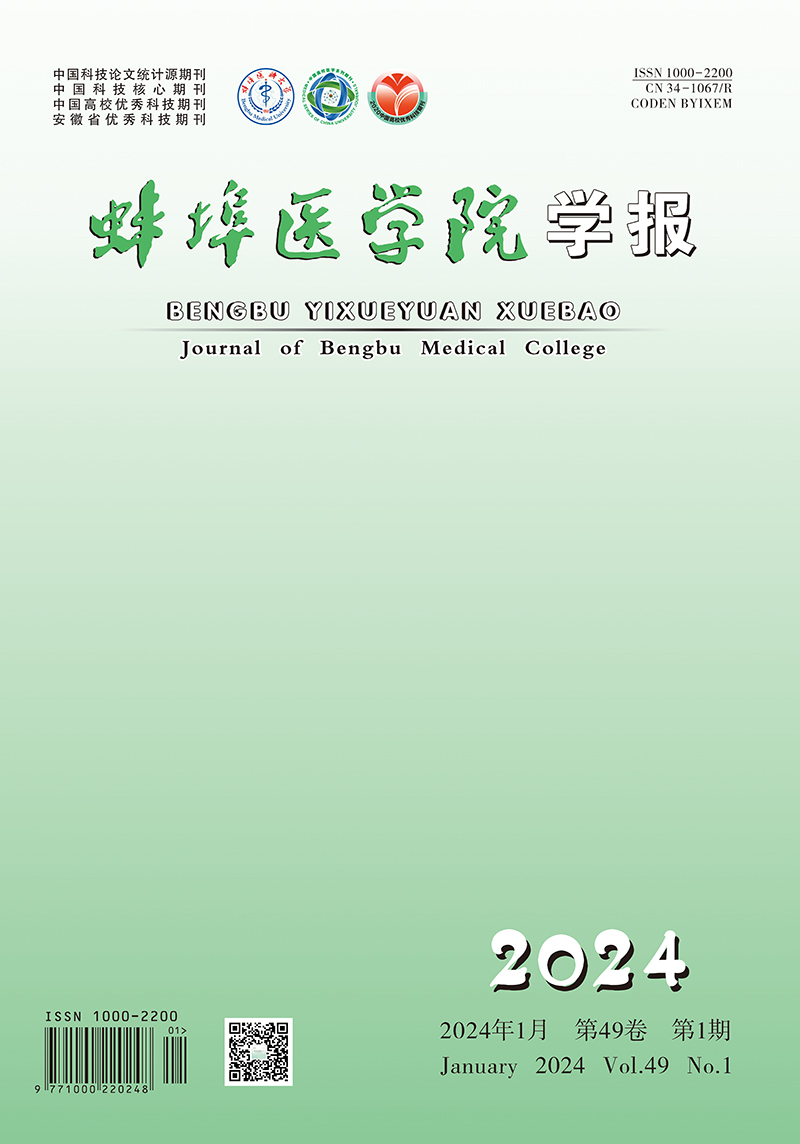-
类风湿关节炎(rheumatoid arthritis,RA)是一种常见的多累及外周关节的自身免疫性疾病,常发生关节局部和全身性骨丢失,而全身性骨质流失会导致骨质疏松(osteoporosis,OP)[1]。OP是RA的主要合并症之一,易导致脆性骨折[2],后者又称为骨质疏松性骨折(osteoporotic fracture,OPF),好发于椎体、髋部、骨盆、前臂远端、肱骨近端等部位,其中以椎体最多见[3]。综合国内外相关研究发现,RA病人中OP发生率约为30%,是正常人群的2倍左右[4],而OPF风险则为正常人的2~5倍[5]。肌少症以肌肉质量下降、力量减退为特点,可以致残、致低生活质量甚至致死[6]。研究[6-7]报道RA病人中肌少症的发病率为25.9%~43.3%。肌少症和OP的联合作用会导致RA病人行动困难、跌倒和脆性骨折[8]。本文旨在探讨肌少症在女性RA病人病情以及继发OP发生中的作用,为女性RA病人OP的临床防治提供理论依据。
HTML
-
选取2017年1月至2020年1月在安徽医科大学第一附属医院风湿免疫科就诊的RA病人239例,其中女187例(女性组),男52例(男性组),均符合1987年、2009年ACR提出的RA分类诊断标准。女性RA病人年龄50~68岁, 体质量48.00~60.00 kg, 身高153.00~160.00 cm, 体质量指数(BMI)19.53~24.61 kg/m2;男性RA病人年龄52~69岁, 体质量51.00~65.00 kg, 身高160.50~170.00 cm,BMI 18.39~23.40 kg/m2。2组病人年龄、体质量、身高、BMI均有可比性。本研究按照赫尔辛基宣言的原则进行,获得安徽医科大学伦理委员会批准,病人均知情同意。
-
由临床医生详细记录所有受试者的病程、关节压痛数(TJC)、关节肿胀数(SJC)、视觉模拟评分(VAS)、晨僵时间、血沉(erythrocyte sedimentation rate,ESR)、C反应蛋白(CRP)、类风湿因子(RF)、抗环瓜氨酸抗体(anti-CCP)等。通过TJC、SJC、ESR和自身综合评分(GH)计算基于28个关节的疾病活动性积分(DAS28),计算公式: DAS28=0.56×TJC+0.28×SJC+0.70×lnESR+0.014×GH。根据ACR1991修订的全球功能状态分类标准(Ⅰ~Ⅳ级)判断RA病人的关节功能。采用健康评估问卷(HAQ)对RA病人进行日常生活能力评估。HAQ分数最高为3分,分数越高提示关节功能越差、残疾程度越高。
-
基于骨骼肌与脂肪组织中水分和电解质的含量差异,采用生物电阻抗分析法(BIA)(InBody 720,BioSpace,韩国首尔)检测肌肉质量估计值。骨骼肌质量指数(SMI)通常测定四肢和躯干部位,计算公式: SMI=骨骼肌质量/身高2。根据亚洲肌少症工作组制定的肌少症诊断标准: (1)据生物电阻抗分析法,男性SMI<7.0 kg/m2,女性SMI<5.7 kg/m2;(2)握力,男性<26 kg,女性<18 kg;(3)日常步态速度<0.8 m/s。符合第一项以及后两项中的任意一项,则满足肌少症的诊断。根据是否存在肌少症,将女性RA病人分为肌少症组和无肌少症组,比较2组病人年龄、病程、BMI、BMD、OP发生率、疾病活动性相关指标(关节肿胀数、压痛数、VAS、晨僵时间、DAS28积分、ESR、CRP、RF、抗CCP)及关节功能相关指标(关节功能分级、HAQ评分)。
-
采用GE Lunar Prodigy双能X线骨密度仪,测量所有研究对象的股骨颈和总髋部及L1~L4的BMD。骨量减少是指低于同性别正常骨峰值1.0个标准差,而OP则是指低于正常同性别骨峰值2.5个标准差[9-10]。
-
采用MECALL Castor-50-hf型X射线扫描仪,对受试者进行双手(包括手腕和手指)摄片,评估X线分期(Ⅰ~Ⅳ级)。Sharp评分: 根据放射科医生盲法对双手包括双腕关节进行关节间隙和骨侵蚀的评分,所有区域的关节间隙狭窄评分为0~144分,关节侵蚀评分为0~170分,总分为0~314分。
-
采用t检验、χ2检验、秩和检验、直线相关分析和logistic回归分析。
1.1. 一般资料
1.2. 临床资料记录与检测方法
1.2.1. 临床资料记录和评估
1.2.2. 肌肉质量测定和肌少症判断标准
1.2.3. 骨密度(BMD)测定和OP判断标准
1.2.4. 双手X线摄片和Sharp评分
1.3. 统计学方法
-
女性组病人SMI明显低于男性组(P<0.01);女性组病人股骨颈、总髋部、L1、L2、L3、L4部位BMD均低于男性组(P<0.05~P<0.01)(见表 1)。
分组 n SMI/(kg/m2) 股骨颈-BMD/(g/cm2) 总髋部-BMD/(g/cm2) L1-BMD/(g/cm2) L2-BMD/(g/cm2) L3-BMD/(g/cm2) L4-BMD/(g/cm2) L1~4-BMD/(g/cm2) 女性组 187 5.47±0.89 0.73(0.65,0.85) 0.79±0.14 0.87±0.16 0.91±0.17 0.99±0.19 1.00(0.89,1.16) 0.98±0.18 男性组 52 6.51±0.89 0.84(0.76,0.92) 0.88±0.10 0.93±0.18 0.98±0.13 1.05±0.14 1.06(0.94,1.16) 1.03±0.13 t — 7.45 4.46△ 4.34 2.33 2.75 2.12 1.94△ 1.87 P — <0.01 <0.01 <0.01 <0.05 <0.01 <0.05 <0.05 >0.05 △示uc值 -
2组肌少症发生率差异无统计学意义(P>0.05);女性组病人股骨颈、总髋部、L1、L2、L3、L4、L1~4和总OP的患病率均高于男性组(P<0.05~P<0.01)(见表 2)。
分组 n 肌少症 股骨颈-OP 总髋部-OP L1-OP L2-OP L3-OP L4-OP L1~4-OP 总OP 女性组 187 114(61.0) 40(21.40) 36(19.30) 33(19.60) 62(33.20) 43(23.00) 36(19.30) 36(19.30) 81(43.30) 男性组 52 34(65.4) 3(5.77) 1(1.92) 1(1.92) 2(3.85) 2(3.85) 0(0) 1(1.92) 3(5.77) χ2 — 0.34 7.5 15.56 8.46 18.62 17.45 15.09 12.77 25.18 P — >0.05 <0.05 <0.01 <0.05 <0.01 <0.01 <0.01 <0.01 <0.01 -
肌少症组病人年龄、病程均高于无肌少症组(P<0.01和P<0.05),BMI明显低于无肌少症组(P<0.01);肌少症组股骨颈、总髋部、L1、L2、L3、L4、L1~4部位BMD均明显低于无肌少症组(P<0.01)(见表 3)。肌少症组股骨颈、总髋部、L1、L2、L3、L4、L1~4、总OP发生率均明显高于无肌少症组(P<0.01)(见表 4)。
分组 n 年龄/岁 病程/年 BMI/(kg/m2) 股骨颈-BMD/(g/cm2) 总髋部-BMD/(g/cm2) 无肌少症组 73 56.00(49.00,64.00) 7.00(2.50,15.00) 24.61(22.48,26.95) 0.81(0.71,0.91) 0.87±0.13 肌少症组 114 59.00(51.00,69.00) 11.00(5.00,20.00) 20.55(18.90,22.72) 0.68(0.61,0.78) 0.74±0.13 t — 1.65△ 2.25△ 7.50△ 5.14△ 6.67 P — <0.01 <0.05 <0.01 <0.01 <0.01 分组 n L1-BMD/(g/cm2) L2-BMD/(g/cm2) L3-BMD/(g/cm2) L4-BMD/(g/cm2) L1~4-BMD/(g/cm2) 无肌少症组 73 0.90±0.20 0.97(0.85,1.09) 1.04(0.95,1.20) 1.11±0.18 1.05±0.16 肌少症组 114 0.80±0.17 0.84(0.74,0.99) 0.92(0.82,1.06) 0.96±0.18 0.93±0.17 t — 3.66 4.32△ 4.33△ 5.56 4.82 P — <0.01 <0.01 <0.01 <0.01 <0.01 △示uc值 分组 n 股骨颈-OP 总髋部-OP L1-OP L2-OP L3-OP L4-OP L1~4-OP 总OP 无肌少症组 73 3(4.11) 4(5.48) 5(6.84) 11(15.07) 5(6.85) 6(8.22) 7(9.59) 17(23.29) 肌少症组 114 37(32.46) 32(28.07) 40(35.08) 51(44.74) 38(33.33) 30(26.32) 36(31.58) 64(56.14) χ2 — 29.69 30.36 20.65 17.89 19.45 14.95 23.83 20.13 P — <0.01 <0.01 <0.01 <0.01 <0.01 <0.01 <0.01 <0.01 -
2组病人疾病活动性相关指标(关节肿胀数、压痛数、VAS、晨僵时间、DAS28积分、ESR、CRP、RF、抗CCP)及关节功能相关指标(关节功能分级、HAQ评分)差异均无统计学意义(P>0.05);2组病人关节X线分期构成比(Ⅰ~Ⅳ级)差异有统计学意义,肌少症组Ⅳ级的比例高于无肌少症组(P<0.05);肌少症组Sharp评分明显高于无肌少症组(P<0.01)(见表 5)。
分组 n 关节肿数 关节压痛 VAS/分 晨僵时间/min ESR/(mm/h) CRP/(mg/L) RF/(IU/L) 无肌少症组 73 2.00(1.00,6.00) 8.00(3.00,14.00) 5.00(3.00,7.00) 5.00(0.00,30.00) 53.04±30.26 18.80(7.60,44.30) 92.40(14.90,223.20) 肌少症组 114 2.00(1.00,6.00) 8.00(4.00,13.00) 5.00(4.00,7.00) 2.00(0.00,30.00) 57.47±26.84 17.30(7.50,52.10) 98.00(41.80,222.40) uc — 0.48 0.03 0.38 0.60 1.05△ 0.26 0.45 P — >0.05 >0.05 >0.05 >0.05 >0.05 >0.05 >0.05 分组 n DAS28 抗CCP抗体/(RU/mL) 关节功能
(Ⅰ∶Ⅱ∶Ⅲ∶Ⅳ)X线分期
(Ⅰ∶Ⅱ∶Ⅲ∶Ⅳ)HAQ评分/分 Sharp评分/分 无肌少症组 73 4.78±1.10 651.00(59.00,910.00) 11∶35∶22∶5 2∶18∶38∶15 1.00(0.40,1.75) 41(12,78) 肌少症组 114 4.88±1.08 703.00(225.00,985.00) 17∶47∶45∶5 2∶22∶42∶48 1.30(0.70,1.85) 75(23,159) uc — 0.61△ 1.24 0.56 2.56 1.24 2.99 P — >0.05 >0.05 >0.05 <0.05 >0.05 <0.01 △示t值 -
女性RA病人SMI与病程、年龄、HAQ评分、X线分期、Sharp评分均呈负相关关系(r=-0.155、-0.196、-2.040、-0.244、-0.365,P<0.05~P<0.01),与股骨颈-BMD、L1-BMD、L2-BMD、L3-BMD、L4-BMD、L1~4-BMD呈明显正相关关系(r=0.422、0.410、0.380、0.423、0.434、0.437,P<0.01)。
-
以是否发生OP(无OP=0,OP=1)为应变量,以年龄、病程、HAQ评分、DAS28、Sharp评分、SMI为自变量,多元logistic回归分析结果显示,SMI值是女性RA病人发生OP的保护因素(OR=0.340,95%CI: 0.220~0.540,P<0.01);年龄是女性RA病人发生OP的危险因素(OR=1.090,95%CI: 1.050~1.130,P<0.01)。以女性RA病人的DAS28为应变量,以年龄、病程、HAQ评分、RF、抗CCP抗体、SMI为自变量,多元线性回归分析结果显示,病程、HAQ评分是女性RA病人DAS28的影响因素(β=-0.018、0.583,95%CI: -0.031~-0.005、0.405~0.761,P<0.05和P<0.01)。
2.1. 2组病人SMI和BMD比较
2.2. 2组病人肌少症、OP发生率比较
2.3. 女性RA病人无或有肌少症组一般资料、BMD、OP比较
2.4. 女性RA病人无或有肌少症组疾病活动性、关节功能、关节结构损害比较
2.5. 女性RA病人SMI与各指标的相关性分析
2.6. 女性RA病人发生OP以及DAS28的多元回归分析
-
肌少症的定义是骨骼肌质量和力量的丧失,这两者都随着年龄的增长而逐渐下降,有研究[11]报道60~70岁老年人中肌少症的患病率为5%~13%。而据欧洲老年人肌少症工作组调查显示, 普通社区居民中老年人的患病率高达29%[12]。与健康人相比,RA病人出现肌少症的比例更高。TORII等[13]研究显示,RA病人中肌少症患病率为37.1%;合并肌少症的RA病人预后相对较差,其发生BMD减低、跌倒、骨折的比例明显增高;肌少症与病人的年龄、病程、关节破坏和营养不良程度呈正相关关系,而与生物制剂DMARDs的使用呈负相关关系。DOGAN等[14]研究提示RA病人中肌少症的发病率为43.3%。MOCHIZUKI等[15]发现RA病人肌少症的患病率为29.6%,肌少症与RA病人的年龄、BMI、CRP和髋部BMD相关。NGEULEU等[16]对123例RA病人进行研究发现,肌少症患病率为39.8%,其发生与DAS28、ESR、骨侵蚀、心脏代谢风险增加和HAQ评分有关。本研究中,男性、女性RA病人肌少症患病率分别为65.4%、61.0%,其差异无统计学意义,提示RA病人中肌少症的发生与性别无关。导致本研究与先前国内外研究中肌少症患病率差异的原因可能与地域、人种、BMI水平,尤其是测定仪器和评估方法不同等有关。
本研究进一步探讨肌少症对女性RA病人病情的影响,结果提示合并肌少症的女性RA病人通常较无肌少症者病程更长、BMI更低,这与之前的研究结果是一致的。有、无肌少症组间的女性RA病人疾病活动性指标之间的差异无统计学意义,提示肌少症与女性RA本身疾病活动性无明显相关性。合并肌少症的女性RA病人关节X线分级Ⅳ级的比例明显增加,Sharp评分也更高,提示随着肌少症的出现,女性RA病人有更多的关节受累和更严重的骨质破坏。相关分析提示,女性RA病人SMI与病程、年龄、HAQ评分、X线分期、Sharp评分呈负相关关系;与脊椎各部位BMD呈正相关关系。以上结果证实,女性RA病人中肌少症的发生与病人年龄、病程、骨侵蚀、关节功能状态、骨密度是密切相关的。
RA是一种主要累及小关节的慢性全身性炎症性疾病,易致残,与局部、全身骨质疏松密切相关,在某些病人中,RA的临床前阶段已经存在局部骨丢失,而病程越长、炎症越难控制的RA病人发生OPF(即髋部和脊椎骨折)的风险越高。最常见的骨折部位是脊柱胸腰段、髋部,且多数隐匿发生,一旦出现将是灾难性的,造成非常高的疾病负担,使病人生活质量受损,增加了医疗成本以及死亡率。TONG等[17]提出,RA病人的OP与高龄、女性、低BMI、高疾病活动度密切相关。本研究中,女性RA病人OP发生率为43.3%,明显高于男性RA病人,提示RA病人OP与性别相关,女性RA病人更容易出现OP。女性RA病人若合并肌少症,OP发生率将显著增加。本研究通过logistic回归分析女性RA病人发生OP的影响因素,结果提示SMI值是RA病人发生OP的保护因素;年龄是RA病人发生OP的危险因素。这意味着SMI每增加1 kg/m2,女性RA病人发生OP的风险则减低65.9%;而年龄每增加1岁,风险则增加8.8%。提示女性RA病人OP的发生与肌少症密切相关,而年龄越大,OP越容易发生。既往研究[18]表明,下肢肌力减低、平衡能力减退与跌倒风险的增加显著相关。RA病人若继发OP且同时合并肌少症时容易出现行动不便,增加跌倒、骨折甚至死亡的风险。这提示在日常临床工作中,需要重视对RA病人的健康教育,加强其肌肉力量的训练,有效避免跌倒而导致脊椎骨质疏松性骨折(VOPF),以此改善病人的生活质量,防止病情恶化。
在RA的致病过程中,尤其在抗瓜氨酸化蛋白自身抗体(ACPAs)阳性的RA病人中,肿瘤坏死因子-α(TNF-α)、白细胞介素-6(IL-6)等炎症因子分泌增加,持续作用于关节及其周围部位,引起关节周围骨质丢失,导致骨质疏松。与健康个体相比,大多数RA病人的骨骼肌细胞质量有所减少,而脂肪质量保持或有所增加。VISSER等[19]曾报道RA病人血液中高水平的TNF-α、IL-6、CRP与肌力下降有关,这些细胞因子增加了肌肉组织合成过程中的蛋白质分解。除了这些细胞因子,氧化应激和体力活动减少也可能导致肌肉丢失,导致蛋白质合成代谢和分解代谢失衡。RA长期暴露在炎症中,骨质和肌肉质量都受到严重影响,若不及时进行干预,肌少症、OP甚至VOPF发生的概率大大增加。因此,如果在疾病早期及时应用拮抗TNF-α、IL-6的bDMARDS抑制炎性细胞因子引起的蛋白质分解代谢和骨质丢失,则可能达到预防肌少症和骨质疏松发生的目的。在加强对病人进行宣教,指导病人适度锻炼,加强骨骼肌力量的训练的同时还需要重视并提高RA病人的平衡能力,防止跌倒而出现骨折。
综上所述,女性RA病人容易合并OP,其发生受多种因素影响;肌少症是OP的危险因素,其与RA病人的关节结构损伤密切相关。且随着年龄越大,SMI越低、OP发生风险越大,更容易出现跌倒导致VOPF,VOPF危害极大,严重影响了病人的生活质量和疾病预后,在临床工作中应该重视RA病人肌肉质量、力量的锻炼以及提升,延缓关节结构损伤,尽量减少OP的发生。






 DownLoad:
DownLoad: